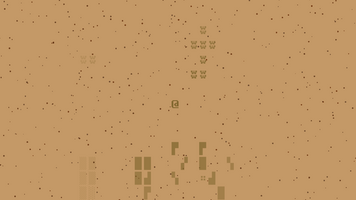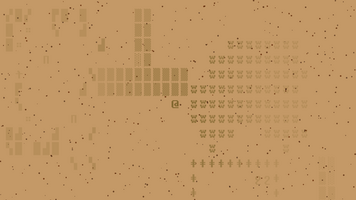Developer Notes



Thanks for playing my 2018 #procjam entry! This is a short post explaining more about Nothing Beside Remains. It's designed to be read after playing the game, but doesn't reveal anything about the underlying game systems.
What Is This Game About?
As you might have gathered from the (sparse) description text, this game is partly inspired by the poem Ozymandias by Shelley. You play a wanderer in search of a ruined village somewhere in the wilderness. The game begins as you arrive in the village, before the remains of a huge statue proclaiming the importance of this place. It's not made clear how long the village has been abandoned, but it's implied that it is many generations ago.
The game's objective, insofar as it has one, is to discover what happened to this village. As you walk around you'll discover ruined buildings, evidence of civilisation, some natural features like water sources, and more. There's no way to definitively know how this society ended, but the texture and content of the village may give you clues. What parts of the surrounding ecosystem did you see? What kinds of buildings were left behind? What did the people here commemorate or ward against?
I've written a spoiler-filled post where I go into more detail about the generative systems, but here I'll just say that the simulation of this village is not particularly detailed or true to how historical groups lived. But there are systems in place, and they inform both the shape and content of the village you explore. The village you saw did have clues - however slight - to what its fate was. Knowing what they are is difficult and, of course, largely about whether your mental model of the game's systems line up with mine as the designer.
Small-Batch Procedural Generation
A big motivation behind the game is actually shared with the original reasons for founding PROCJAM: to try and think about, and work with, and get people playing with generative software in different ways. The game is designed to only be played once - this is a mix of artistic and technical goals. The game is small, and so playing it once protects you from seeing repetition of content. But it also stops you from easily intuiting the differences between two villages. Talking to other people who played the game may help you understand what makes two villages different, and what makes them the same, and might even help you figure out what led your village to collapse.
Another important aspect of the game is that it doesn't confirm or deny your findings, there's no way to even input 'findings' into the game, nor to return to a village later or show it to anyone else. The village just is, and your idea about what happened to it may or may not be correct. This mixes in with the idea that you're seeing generated content on multiple levels: the actual state of the world now is procedurally generated, but you're also seeing another piece of generated content - the society and its history - filtered through this lens of ruin and decay. This second kind of content is really interesting to me, content that is unreliably shown to the player, sort of like a story being told with a biased view, or reading a translation of poetry written in another language.
I'm also interested in how players perceive generative systems, and how their mind can be encouraged to wander if we don't leave them with as much explicit truth to build on. One of the reasons I've been light on details for the generation here is that there's a lot of ways you could interpret the game's description and content - you might imagine vast, complex village simulations, a light high-level idea, complex cultural generation, ecosystem modelling, all kinds of things. Whatever level you imagine this game working at will also change what clues you look for, how you interpret the layout and content of villages, and what story you make in your head about what happens. That's so valuable, and also so fragile. In games where we constantly regenerate content, or are shown dozens of the same generator output in one play session, our model very rapidly converges towards the actual code (perhaps never 1:1, but still much closer). Hopefully Nothing Beside Remains can be a bit mysterious still to many of you.
Ultimately, I didn't have the time to fully explore these ideas here, and so it's ended up extremely hard to really intuit a village's fate from the information provided. But it helped me explore some of the things I want to do in the future, and I think the villages have a nice feel to them even if the whole project was a bit rushed.
Inspiration
NBR is a prototype of a much larger game I'd like to make some day, that's been on my mind for many years. I was inspired to make this little prototype after enjoying Loren Schmidt's work on Nectar Thief, which is being built incrementally in small steps to allow for reflection, feedback and experimentation. This is a similar 'early first step' for a game I probably won't make for several years.
The game is also inspired by a number of old and new projects, including the following:
- Mark Johnson's Ultima Ratio Regum
- Emily Short's Annals of the Parrigues
- Bay 12 Games' Dwarf Fortress
- Lucas Pope's Return of the Obra Dinn
Nothing Beside Remains
Look On Their Works, And Despair
| Status | In development |
| Author | ill omens |
| Tags | Procedural Generation, PROCJAM |
| Languages | English |
More posts
- [Spoilers] How The Game WorksOct 28, 2018
Leave a comment
Log in with itch.io to leave a comment.